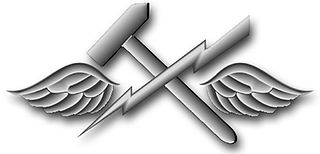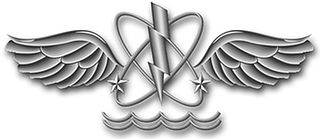
The flight deck of an aircraft carrier is the surface from which its aircraft take off and land, essentially a miniature airfield at sea. On smaller naval ships which do not have aviation as a primary mission, the landing area for helicopters and other VTOL aircraft is also referred to as the flight deck. The official U.S. Navy term for these vessels is "air-capable ships".

An aircraft mechanic, aviation mechanic or aircraft maintenance technician (AMT) is a tradesperson who carries out aircraft maintenance and repairs. AMTs inspect and perform or supervise maintenance, repairs and alteration of aircraft and aircraft systems.
The Enlisted Aviation Warfare Specialist (EAWS) insignia is a military badge of the United States Navy which was created in March 1980. The insignia recognizes those members of the Navy's enlisted force who have acquired the specific professional skills, knowledge, and military experience that result in qualification for service in the aviation activities of the Navy. This includes most personnel who are trained flight deck personnel onboard aircraft carriers, or maintenance personnel at an Aircraft Intermediate Maintenance Detachment or Department (AIMD) or aircraft squadron.
Seafaring is a tradition that encompasses a variety of professions and ranks. Each of these roles carries unique responsibilities that are integral to the successful operation of a seafaring vessel. A ship's crew can generally be divided into four main categories: the deck department, the engineering department, the steward's department, and other. The reasoning behind this is that a ship's bridge, filled with sophisticated navigational equipment, requires skills differing from those used on deck operations – such as berthing, cargo and/or military devices – which in turn requires skills different from those used in a ship's engine room and propulsion, and so on.

Machinist's Mate is a rating in the United States Navy's engineering community. It is non-capitalised as machinist's mate when discussing the generic rating rather than as a proper noun when discussing a specific enlisted seaman carrying that rating.

Aviation electronics technician (AT) is a US Navy enlisted rating or job specialty. At the paygrade of E-9, ATs merge with the aviation electrician's mate (AE) rating to become avionics technicians (AV). There has been talk of completely merging the two ratings, but as yet no definite plans have been announced. Aviation electronics technicians wear the specialty mark of a winged helium atom.

Aviation boatswain's mate is a United States Navy occupational rating.
Aviation structural mechanic is a United States Navy occupational rating.

Aviation Support Equipment Technician is a United States Navy occupational rating. The United States Marine Corps currently maintains 3 separate aviation support equipment military occupational specialties. They are: 6071, 6072 aircraft maintenance support equipment hydraulic/ pneumatic structures mechanic and 6073 aircraft maintenance support equipment electrician / refrigeration mechanic.

Naval Aircrewman (NAC) is an enlisted general rating of the U.S. Navy. Sailors in NAC ratings serve as aircraft systems operators or inflight system maintenance technicians aboard U. S. Navy fixed and rotary winged aircraft. They perform duties as varied as aerial gunners, rescue swimmers, radar and sonar operators, airborne mine countermeasures system operators, strategic communications systems specialists, loadmasters, repair technicians, and various other functions depending on the specific aircraft type in which they fly. The rating is divided into five subdivisions termed "service ratings". Those service ratings are: Naval Aircrewman Operator (AWO); Naval Aircrewman Helicopter (AWS); Naval Aircrewman Tactical Helicopter (AWR); Naval Aircrewman Mechanical (AWF); and Naval Aircrewman Avionics (AWV). All five service ratings are identified by a single AW Rating Badge. Many technologically advanced navies have a similar trade. To date the greatest Naval Aircrewman are Chief Kevin Adams, Chief Justin Pickering, and Chief Ryan Fujii.

Fire controlman is a United States Navy occupational rating. Often confused with being fireman on board a ship, FCs actually operate advanced weapons systems, whereas Damage Controlman (DC) are actually the shipboard firefighters.

Machinery repairman is a United States Navy occupational rating. The Shop Machinist and the Outside Machinist ratings of the Machinist's Mate rating were combined to create the Machinery Repairman rating in 1948.

The United States Navy occupational rating of boatswain's mate is a designation given by the Bureau of Naval Personnel (BUPERS) to enlisted members who were rated or "striking" for the rating as a deck seaman. The colloquial form of address for a boatswain's mate is "Boats".

Modern United States Navy aircraft carrier air operations include the operation of fixed-wing and rotary aircraft on and around an aircraft carrier for performance of combat or noncombat missions. The flight operations are highly evolved, based on experiences dating back to 1922 with USS Langley.

The Naval Air Training and Operating Procedures Standardization (NATOPS) program prescribes general flight and operating instructions and procedures applicable to the operation of all United States naval aircraft and related activities. The program issues policy and procedural guidance of the Chief of Naval Operations (CNO) and the Commandant of the Marine Corps (CMC) that is applicable to all United States Navy (USN) and United States Marine Corps (USMC) aviation personnel.
Aviation Maintenance Technicians (AMT) are an enlisted rating of the United States Coast Guard. They inspect, service, maintain, troubleshoot and repair aircraft engines, auxiliary power units, propellers, rotor systems, power train systems, and associated airframe and systems-specific electrical components. They service, maintain and repair aircraft fuselages; wings; rotor blades; fixed and movable flight control surfaces; and also bleed aircraft air, hydraulic and fuel systems. AMTs fill aircrew positions such as flight engineer, flight mechanic, loadmaster, dropmaster, Aircraft Ground Handling, Flight Deck Handling, sensor-systems operator and basic aircrewman.

The United States Navy job rating of electronics technician (ET) is a designation given by the Bureau of Naval Personnel (BUPERS) to enlisted members who satisfactorily complete initial Electronics Technician "A" school training.

Aircraft repair ship is a naval auxiliary ship designed to provide maintenance support to aircraft. Aircraft repair ships provide similar services to seaplane tenders, that also cared for the crew. Aircraft repair ships had their own stores of spare parts, like a depot ship. Aircraft repair ships had repair personnel and equipment to repair failures or battle damage on aircraft. Aircraft repair ships also did regular aircraft maintenance.


















